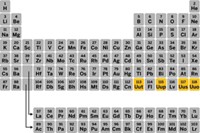Advertisement
Grab your lab coat. Let's get started
Welcome!
Welcome!
Create an account below to get 6 C&EN articles per month, receive newsletters and more - all free.
It seems this is your first time logging in online. Please enter the following information to continue.
As an ACS member you automatically get access to this site. All we need is few more details to create your reading experience.
Not you? Sign in with a different account.
Not you? Sign in with a different account.
ERROR 1
ERROR 1
ERROR 2
ERROR 2
ERROR 2
ERROR 2
ERROR 2
Password and Confirm password must match.
If you have an ACS member number, please enter it here so we can link this account to your membership. (optional)
ERROR 2
ACS values your privacy. By submitting your information, you are gaining access to C&EN and subscribing to our weekly newsletter. We use the information you provide to make your reading experience better, and we will never sell your data to third party members.
Physical Chemistry
Element 117 Repeat
Superheavy element is now eligible to become the new end of the periodic table, if the findings are judged to be conclusive
by Jyllian Kemsley
May 12, 2014
| A version of this story appeared in
Volume 92, Issue 19
Four years after scientists first reported the creation of element 117, researchers working at a second facility have observed it as well (Phys. Rev. Lett. 2014, DOI: 10.1103/physrevlett.112.172501). The additional finding should strengthen the case for adding element 117 to the periodic table, where it would take its place as the heaviest element confirmed to exist, even if it does so only briefly. Element 117 was first sighted in 2010 in experiments done at Russia’s Joint Institute for Nuclear Research, where researchers smashed a stream of 48Ca atoms into a 249Bk target. The scientists tracked two isotopes, 293117 and 294117, through their nuclear decay chains. Similar experiments in Russia turned up element 117 again in 2012. In the new work, scientists led by Jadambaa Khuyagbaatar at Germany’s GSI heavy-ion accelerator center also combined 48Ca and 249Bk and saw evidence of two atoms of 294117. In the past two years, researchers have repeated sightings of elements 113 and 115 as well. If an international committee deems all the claims conclusive, row seven of the periodic table will be only one element short of completion.





Join the conversation
Contact the reporter
Submit a Letter to the Editor for publication
Engage with us on Twitter